Family Law Assignment: Best Outcomes for Children in Family Disputes
VerifiedAdded on 2022/09/14
|8
|2155
|11
Essay
AI Summary
This research essay critically examines the family law system's encouragement of parents to reach agreements on child arrangements outside of court. The paper argues that, while avoiding court can often be the best approach, it is not always the optimal solution. The essay discusses the potential trauma children face when involved in court proceedings, including manipulation by parents and the pressures of legal environments. It explores the benefits of alternative dispute resolution methods, such as negotiation, arbitration, and family dispute resolution, as outlined in the Family Law Act 1975, to protect children from the harshness of legal battles. The paper references relevant legislation, including the Convention on the Rights of the Child, and case law, such as Hutchings v Clarke, to support its arguments. It also acknowledges instances where court intervention might be necessary. The essay concludes by emphasizing the importance of prioritizing the child's best interests in all decisions concerning family disputes.
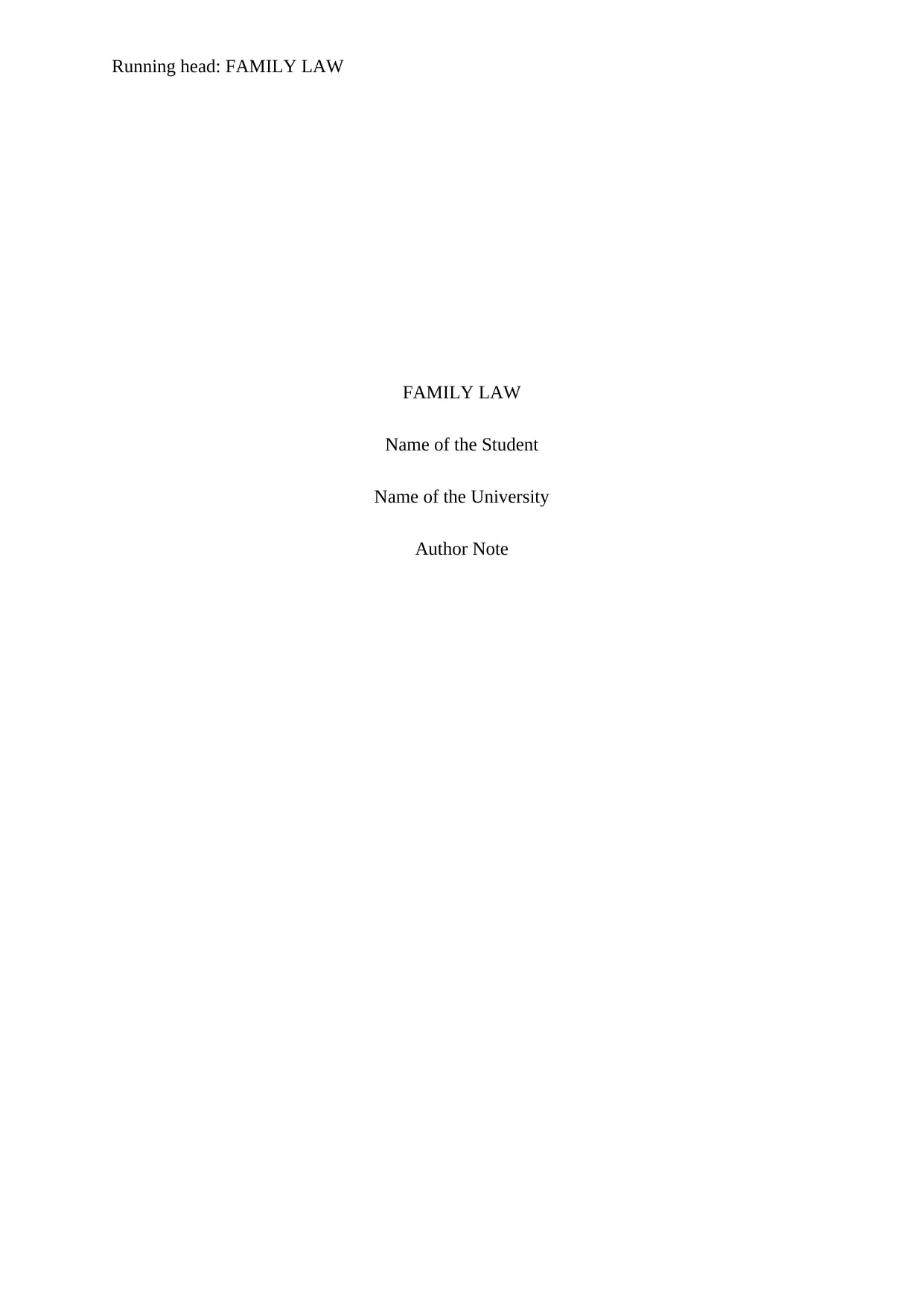
Running head: FAMILY LAW
FAMILY LAW
Name of the Student
Name of the University
Author Note
FAMILY LAW
Name of the Student
Name of the University
Author Note
Paraphrase This Document
Need a fresh take? Get an instant paraphrase of this document with our AI Paraphraser
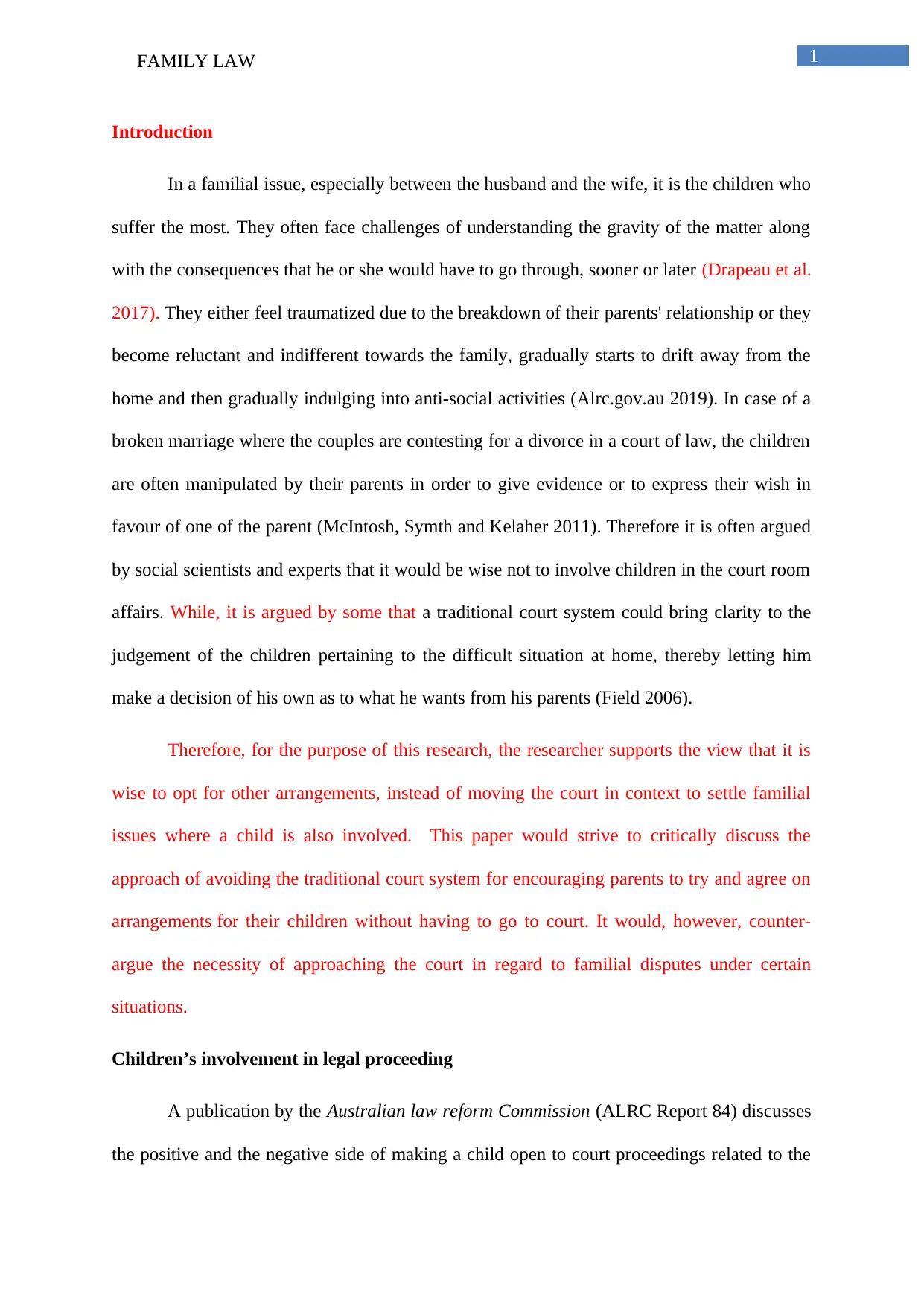
1FAMILY LAW
Introduction
In a familial issue, especially between the husband and the wife, it is the children who
suffer the most. They often face challenges of understanding the gravity of the matter along
with the consequences that he or she would have to go through, sooner or later (Drapeau et al.
2017). They either feel traumatized due to the breakdown of their parents' relationship or they
become reluctant and indifferent towards the family, gradually starts to drift away from the
home and then gradually indulging into anti-social activities (Alrc.gov.au 2019). In case of a
broken marriage where the couples are contesting for a divorce in a court of law, the children
are often manipulated by their parents in order to give evidence or to express their wish in
favour of one of the parent (McIntosh, Symth and Kelaher 2011). Therefore it is often argued
by social scientists and experts that it would be wise not to involve children in the court room
affairs. While, it is argued by some that a traditional court system could bring clarity to the
judgement of the children pertaining to the difficult situation at home, thereby letting him
make a decision of his own as to what he wants from his parents (Field 2006).
Therefore, for the purpose of this research, the researcher supports the view that it is
wise to opt for other arrangements, instead of moving the court in context to settle familial
issues where a child is also involved. This paper would strive to critically discuss the
approach of avoiding the traditional court system for encouraging parents to try and agree on
arrangements for their children without having to go to court. It would, however, counter-
argue the necessity of approaching the court in regard to familial disputes under certain
situations.
Children’s involvement in legal proceeding
A publication by the Australian law reform Commission (ALRC Report 84) discusses
the positive and the negative side of making a child open to court proceedings related to the
Introduction
In a familial issue, especially between the husband and the wife, it is the children who
suffer the most. They often face challenges of understanding the gravity of the matter along
with the consequences that he or she would have to go through, sooner or later (Drapeau et al.
2017). They either feel traumatized due to the breakdown of their parents' relationship or they
become reluctant and indifferent towards the family, gradually starts to drift away from the
home and then gradually indulging into anti-social activities (Alrc.gov.au 2019). In case of a
broken marriage where the couples are contesting for a divorce in a court of law, the children
are often manipulated by their parents in order to give evidence or to express their wish in
favour of one of the parent (McIntosh, Symth and Kelaher 2011). Therefore it is often argued
by social scientists and experts that it would be wise not to involve children in the court room
affairs. While, it is argued by some that a traditional court system could bring clarity to the
judgement of the children pertaining to the difficult situation at home, thereby letting him
make a decision of his own as to what he wants from his parents (Field 2006).
Therefore, for the purpose of this research, the researcher supports the view that it is
wise to opt for other arrangements, instead of moving the court in context to settle familial
issues where a child is also involved. This paper would strive to critically discuss the
approach of avoiding the traditional court system for encouraging parents to try and agree on
arrangements for their children without having to go to court. It would, however, counter-
argue the necessity of approaching the court in regard to familial disputes under certain
situations.
Children’s involvement in legal proceeding
A publication by the Australian law reform Commission (ALRC Report 84) discusses
the positive and the negative side of making a child open to court proceedings related to the
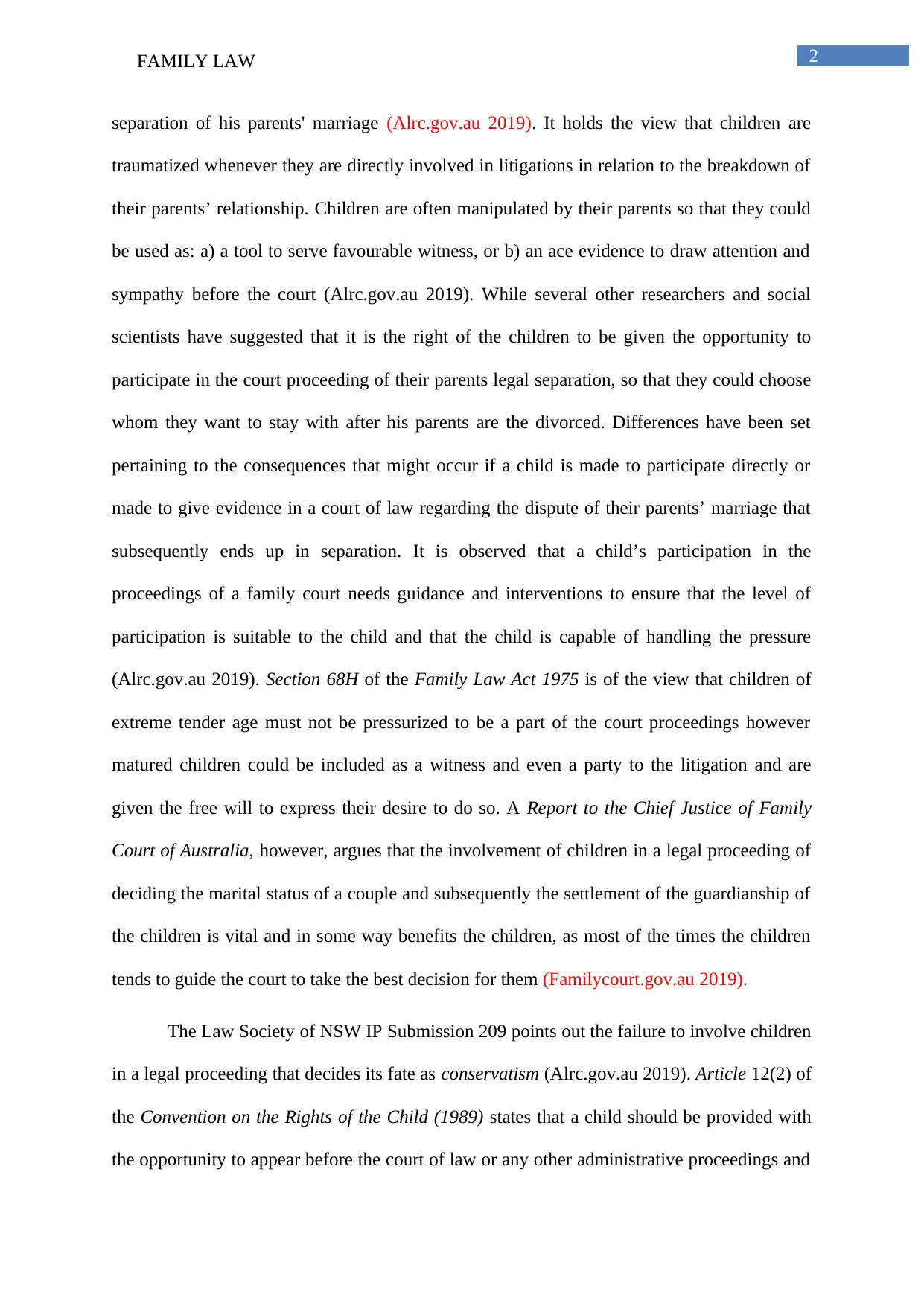
2FAMILY LAW
separation of his parents' marriage (Alrc.gov.au 2019). It holds the view that children are
traumatized whenever they are directly involved in litigations in relation to the breakdown of
their parents’ relationship. Children are often manipulated by their parents so that they could
be used as: a) a tool to serve favourable witness, or b) an ace evidence to draw attention and
sympathy before the court (Alrc.gov.au 2019). While several other researchers and social
scientists have suggested that it is the right of the children to be given the opportunity to
participate in the court proceeding of their parents legal separation, so that they could choose
whom they want to stay with after his parents are the divorced. Differences have been set
pertaining to the consequences that might occur if a child is made to participate directly or
made to give evidence in a court of law regarding the dispute of their parents’ marriage that
subsequently ends up in separation. It is observed that a child’s participation in the
proceedings of a family court needs guidance and interventions to ensure that the level of
participation is suitable to the child and that the child is capable of handling the pressure
(Alrc.gov.au 2019). Section 68H of the Family Law Act 1975 is of the view that children of
extreme tender age must not be pressurized to be a part of the court proceedings however
matured children could be included as a witness and even a party to the litigation and are
given the free will to express their desire to do so. A Report to the Chief Justice of Family
Court of Australia, however, argues that the involvement of children in a legal proceeding of
deciding the marital status of a couple and subsequently the settlement of the guardianship of
the children is vital and in some way benefits the children, as most of the times the children
tends to guide the court to take the best decision for them (Familycourt.gov.au 2019).
The Law Society of NSW IP Submission 209 points out the failure to involve children
in a legal proceeding that decides its fate as conservatism (Alrc.gov.au 2019). Article 12(2) of
the Convention on the Rights of the Child (1989) states that a child should be provided with
the opportunity to appear before the court of law or any other administrative proceedings and
separation of his parents' marriage (Alrc.gov.au 2019). It holds the view that children are
traumatized whenever they are directly involved in litigations in relation to the breakdown of
their parents’ relationship. Children are often manipulated by their parents so that they could
be used as: a) a tool to serve favourable witness, or b) an ace evidence to draw attention and
sympathy before the court (Alrc.gov.au 2019). While several other researchers and social
scientists have suggested that it is the right of the children to be given the opportunity to
participate in the court proceeding of their parents legal separation, so that they could choose
whom they want to stay with after his parents are the divorced. Differences have been set
pertaining to the consequences that might occur if a child is made to participate directly or
made to give evidence in a court of law regarding the dispute of their parents’ marriage that
subsequently ends up in separation. It is observed that a child’s participation in the
proceedings of a family court needs guidance and interventions to ensure that the level of
participation is suitable to the child and that the child is capable of handling the pressure
(Alrc.gov.au 2019). Section 68H of the Family Law Act 1975 is of the view that children of
extreme tender age must not be pressurized to be a part of the court proceedings however
matured children could be included as a witness and even a party to the litigation and are
given the free will to express their desire to do so. A Report to the Chief Justice of Family
Court of Australia, however, argues that the involvement of children in a legal proceeding of
deciding the marital status of a couple and subsequently the settlement of the guardianship of
the children is vital and in some way benefits the children, as most of the times the children
tends to guide the court to take the best decision for them (Familycourt.gov.au 2019).
The Law Society of NSW IP Submission 209 points out the failure to involve children
in a legal proceeding that decides its fate as conservatism (Alrc.gov.au 2019). Article 12(2) of
the Convention on the Rights of the Child (1989) states that a child should be provided with
the opportunity to appear before the court of law or any other administrative proceedings and
⊘ This is a preview!⊘
Do you want full access?
Subscribe today to unlock all pages.

Trusted by 1+ million students worldwide
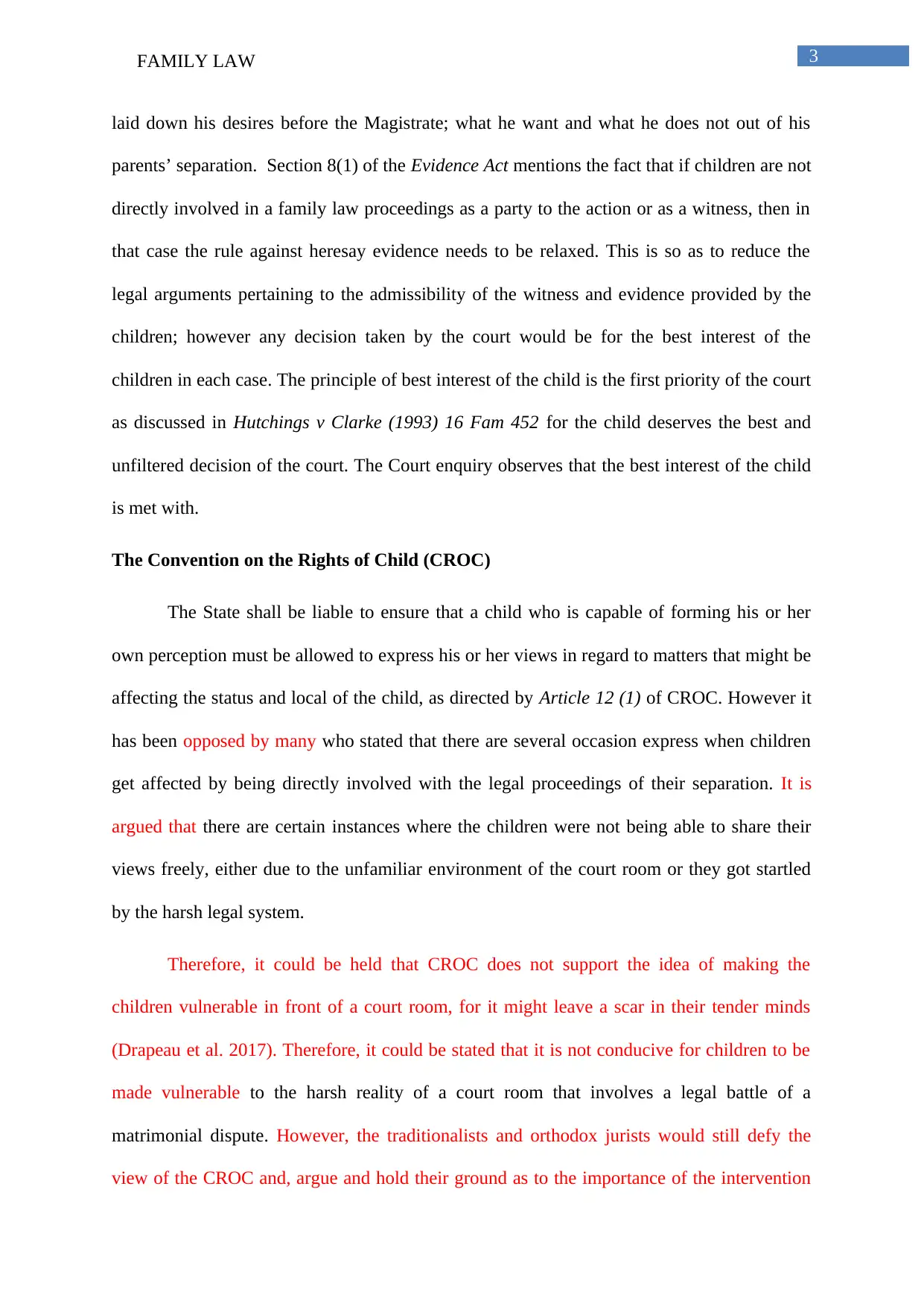
3FAMILY LAW
laid down his desires before the Magistrate; what he want and what he does not out of his
parents’ separation. Section 8(1) of the Evidence Act mentions the fact that if children are not
directly involved in a family law proceedings as a party to the action or as a witness, then in
that case the rule against heresay evidence needs to be relaxed. This is so as to reduce the
legal arguments pertaining to the admissibility of the witness and evidence provided by the
children; however any decision taken by the court would be for the best interest of the
children in each case. The principle of best interest of the child is the first priority of the court
as discussed in Hutchings v Clarke (1993) 16 Fam 452 for the child deserves the best and
unfiltered decision of the court. The Court enquiry observes that the best interest of the child
is met with.
The Convention on the Rights of Child (CROC)
The State shall be liable to ensure that a child who is capable of forming his or her
own perception must be allowed to express his or her views in regard to matters that might be
affecting the status and local of the child, as directed by Article 12 (1) of CROC. However it
has been opposed by many who stated that there are several occasion express when children
get affected by being directly involved with the legal proceedings of their separation. It is
argued that there are certain instances where the children were not being able to share their
views freely, either due to the unfamiliar environment of the court room or they got startled
by the harsh legal system.
Therefore, it could be held that CROC does not support the idea of making the
children vulnerable in front of a court room, for it might leave a scar in their tender minds
(Drapeau et al. 2017). Therefore, it could be stated that it is not conducive for children to be
made vulnerable to the harsh reality of a court room that involves a legal battle of a
matrimonial dispute. However, the traditionalists and orthodox jurists would still defy the
view of the CROC and, argue and hold their ground as to the importance of the intervention
laid down his desires before the Magistrate; what he want and what he does not out of his
parents’ separation. Section 8(1) of the Evidence Act mentions the fact that if children are not
directly involved in a family law proceedings as a party to the action or as a witness, then in
that case the rule against heresay evidence needs to be relaxed. This is so as to reduce the
legal arguments pertaining to the admissibility of the witness and evidence provided by the
children; however any decision taken by the court would be for the best interest of the
children in each case. The principle of best interest of the child is the first priority of the court
as discussed in Hutchings v Clarke (1993) 16 Fam 452 for the child deserves the best and
unfiltered decision of the court. The Court enquiry observes that the best interest of the child
is met with.
The Convention on the Rights of Child (CROC)
The State shall be liable to ensure that a child who is capable of forming his or her
own perception must be allowed to express his or her views in regard to matters that might be
affecting the status and local of the child, as directed by Article 12 (1) of CROC. However it
has been opposed by many who stated that there are several occasion express when children
get affected by being directly involved with the legal proceedings of their separation. It is
argued that there are certain instances where the children were not being able to share their
views freely, either due to the unfamiliar environment of the court room or they got startled
by the harsh legal system.
Therefore, it could be held that CROC does not support the idea of making the
children vulnerable in front of a court room, for it might leave a scar in their tender minds
(Drapeau et al. 2017). Therefore, it could be stated that it is not conducive for children to be
made vulnerable to the harsh reality of a court room that involves a legal battle of a
matrimonial dispute. However, the traditionalists and orthodox jurists would still defy the
view of the CROC and, argue and hold their ground as to the importance of the intervention
Paraphrase This Document
Need a fresh take? Get an instant paraphrase of this document with our AI Paraphraser
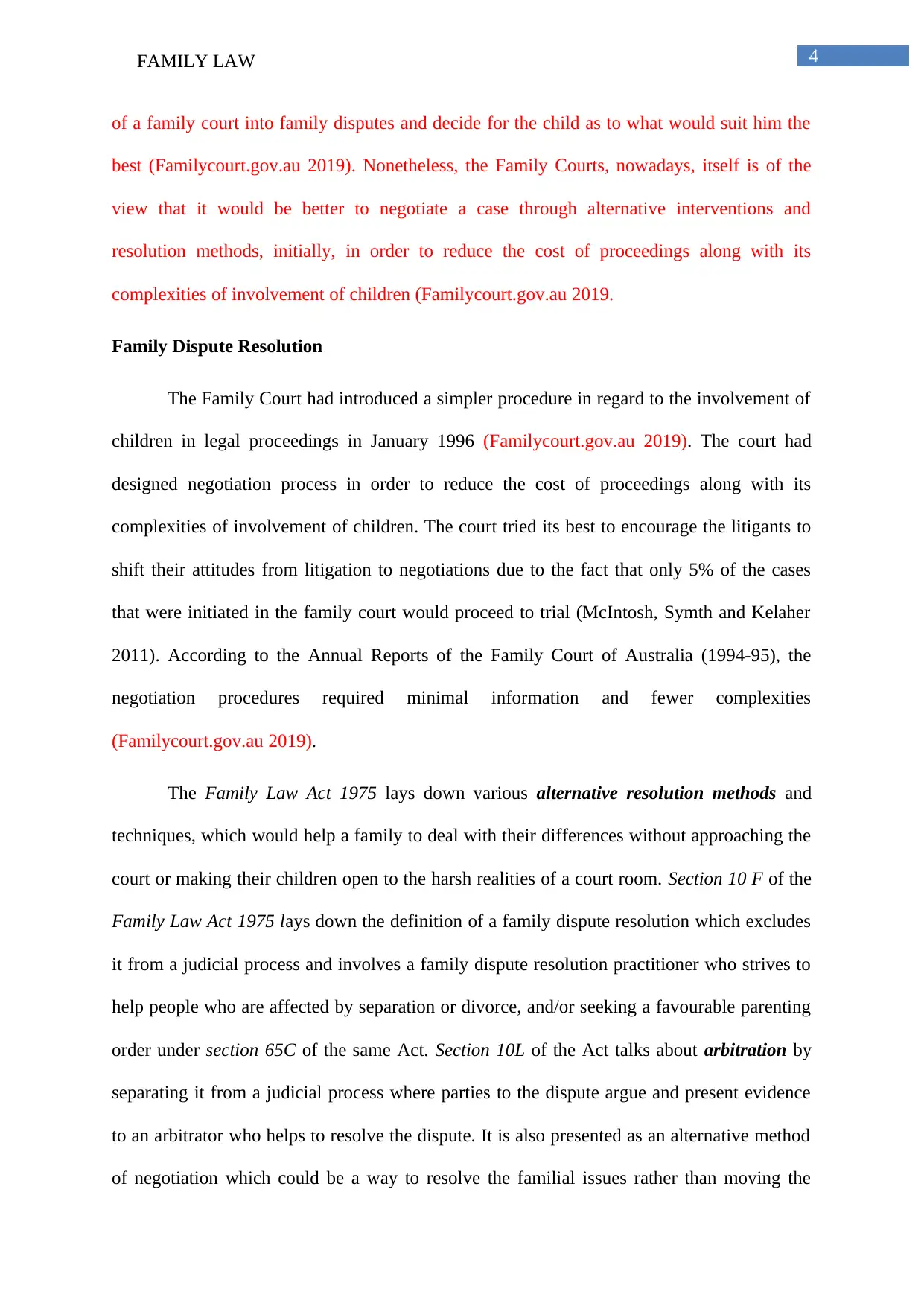
4FAMILY LAW
of a family court into family disputes and decide for the child as to what would suit him the
best (Familycourt.gov.au 2019). Nonetheless, the Family Courts, nowadays, itself is of the
view that it would be better to negotiate a case through alternative interventions and
resolution methods, initially, in order to reduce the cost of proceedings along with its
complexities of involvement of children (Familycourt.gov.au 2019.
Family Dispute Resolution
The Family Court had introduced a simpler procedure in regard to the involvement of
children in legal proceedings in January 1996 (Familycourt.gov.au 2019). The court had
designed negotiation process in order to reduce the cost of proceedings along with its
complexities of involvement of children. The court tried its best to encourage the litigants to
shift their attitudes from litigation to negotiations due to the fact that only 5% of the cases
that were initiated in the family court would proceed to trial (McIntosh, Symth and Kelaher
2011). According to the Annual Reports of the Family Court of Australia (1994-95), the
negotiation procedures required minimal information and fewer complexities
(Familycourt.gov.au 2019).
The Family Law Act 1975 lays down various alternative resolution methods and
techniques, which would help a family to deal with their differences without approaching the
court or making their children open to the harsh realities of a court room. Section 10 F of the
Family Law Act 1975 lays down the definition of a family dispute resolution which excludes
it from a judicial process and involves a family dispute resolution practitioner who strives to
help people who are affected by separation or divorce, and/or seeking a favourable parenting
order under section 65C of the same Act. Section 10L of the Act talks about arbitration by
separating it from a judicial process where parties to the dispute argue and present evidence
to an arbitrator who helps to resolve the dispute. It is also presented as an alternative method
of negotiation which could be a way to resolve the familial issues rather than moving the
of a family court into family disputes and decide for the child as to what would suit him the
best (Familycourt.gov.au 2019). Nonetheless, the Family Courts, nowadays, itself is of the
view that it would be better to negotiate a case through alternative interventions and
resolution methods, initially, in order to reduce the cost of proceedings along with its
complexities of involvement of children (Familycourt.gov.au 2019.
Family Dispute Resolution
The Family Court had introduced a simpler procedure in regard to the involvement of
children in legal proceedings in January 1996 (Familycourt.gov.au 2019). The court had
designed negotiation process in order to reduce the cost of proceedings along with its
complexities of involvement of children. The court tried its best to encourage the litigants to
shift their attitudes from litigation to negotiations due to the fact that only 5% of the cases
that were initiated in the family court would proceed to trial (McIntosh, Symth and Kelaher
2011). According to the Annual Reports of the Family Court of Australia (1994-95), the
negotiation procedures required minimal information and fewer complexities
(Familycourt.gov.au 2019).
The Family Law Act 1975 lays down various alternative resolution methods and
techniques, which would help a family to deal with their differences without approaching the
court or making their children open to the harsh realities of a court room. Section 10 F of the
Family Law Act 1975 lays down the definition of a family dispute resolution which excludes
it from a judicial process and involves a family dispute resolution practitioner who strives to
help people who are affected by separation or divorce, and/or seeking a favourable parenting
order under section 65C of the same Act. Section 10L of the Act talks about arbitration by
separating it from a judicial process where parties to the dispute argue and present evidence
to an arbitrator who helps to resolve the dispute. It is also presented as an alternative method
of negotiation which could be a way to resolve the familial issues rather than moving the
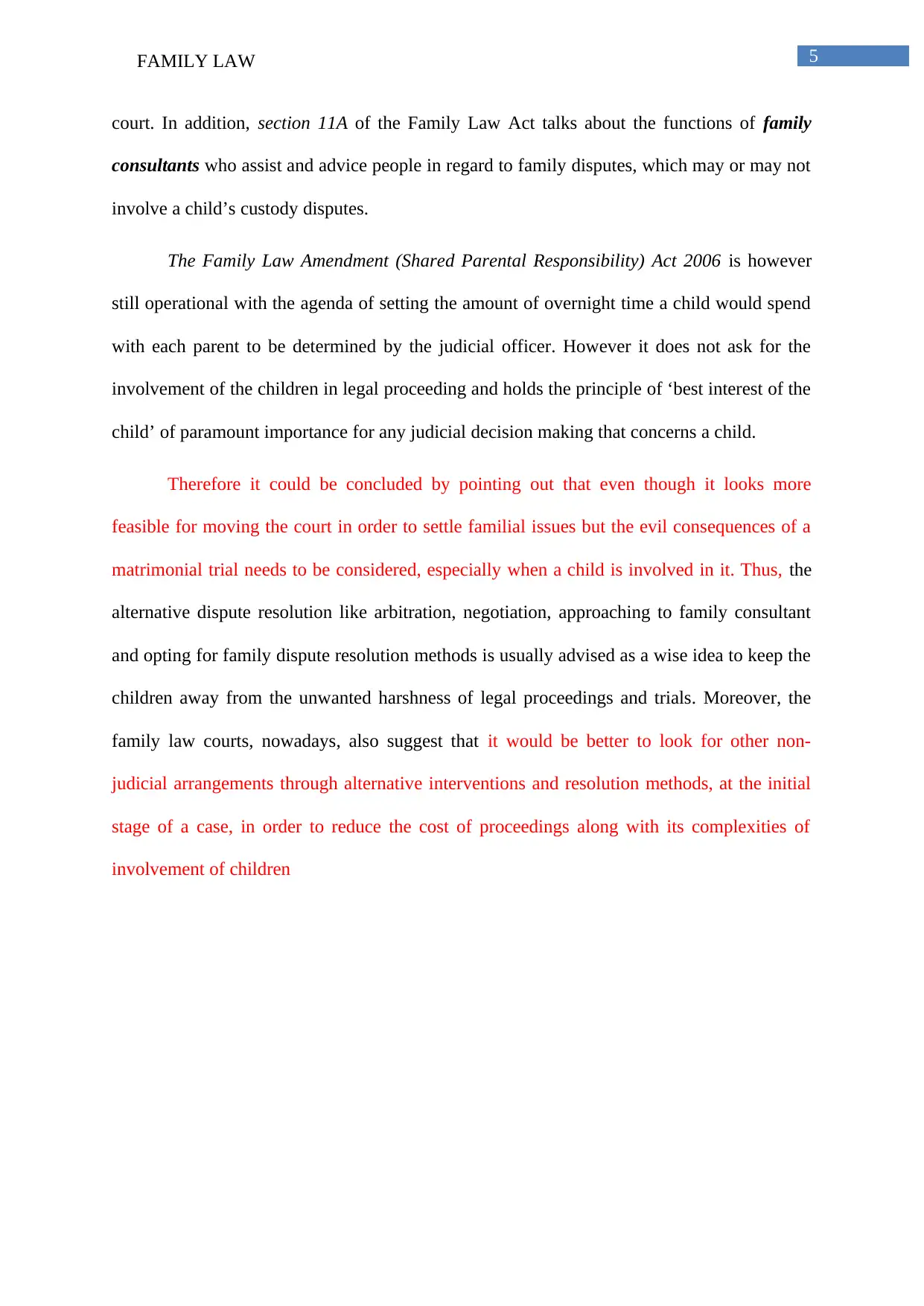
5FAMILY LAW
court. In addition, section 11A of the Family Law Act talks about the functions of family
consultants who assist and advice people in regard to family disputes, which may or may not
involve a child’s custody disputes.
The Family Law Amendment (Shared Parental Responsibility) Act 2006 is however
still operational with the agenda of setting the amount of overnight time a child would spend
with each parent to be determined by the judicial officer. However it does not ask for the
involvement of the children in legal proceeding and holds the principle of ‘best interest of the
child’ of paramount importance for any judicial decision making that concerns a child.
Therefore it could be concluded by pointing out that even though it looks more
feasible for moving the court in order to settle familial issues but the evil consequences of a
matrimonial trial needs to be considered, especially when a child is involved in it. Thus, the
alternative dispute resolution like arbitration, negotiation, approaching to family consultant
and opting for family dispute resolution methods is usually advised as a wise idea to keep the
children away from the unwanted harshness of legal proceedings and trials. Moreover, the
family law courts, nowadays, also suggest that it would be better to look for other non-
judicial arrangements through alternative interventions and resolution methods, at the initial
stage of a case, in order to reduce the cost of proceedings along with its complexities of
involvement of children
court. In addition, section 11A of the Family Law Act talks about the functions of family
consultants who assist and advice people in regard to family disputes, which may or may not
involve a child’s custody disputes.
The Family Law Amendment (Shared Parental Responsibility) Act 2006 is however
still operational with the agenda of setting the amount of overnight time a child would spend
with each parent to be determined by the judicial officer. However it does not ask for the
involvement of the children in legal proceeding and holds the principle of ‘best interest of the
child’ of paramount importance for any judicial decision making that concerns a child.
Therefore it could be concluded by pointing out that even though it looks more
feasible for moving the court in order to settle familial issues but the evil consequences of a
matrimonial trial needs to be considered, especially when a child is involved in it. Thus, the
alternative dispute resolution like arbitration, negotiation, approaching to family consultant
and opting for family dispute resolution methods is usually advised as a wise idea to keep the
children away from the unwanted harshness of legal proceedings and trials. Moreover, the
family law courts, nowadays, also suggest that it would be better to look for other non-
judicial arrangements through alternative interventions and resolution methods, at the initial
stage of a case, in order to reduce the cost of proceedings along with its complexities of
involvement of children
⊘ This is a preview!⊘
Do you want full access?
Subscribe today to unlock all pages.

Trusted by 1+ million students worldwide
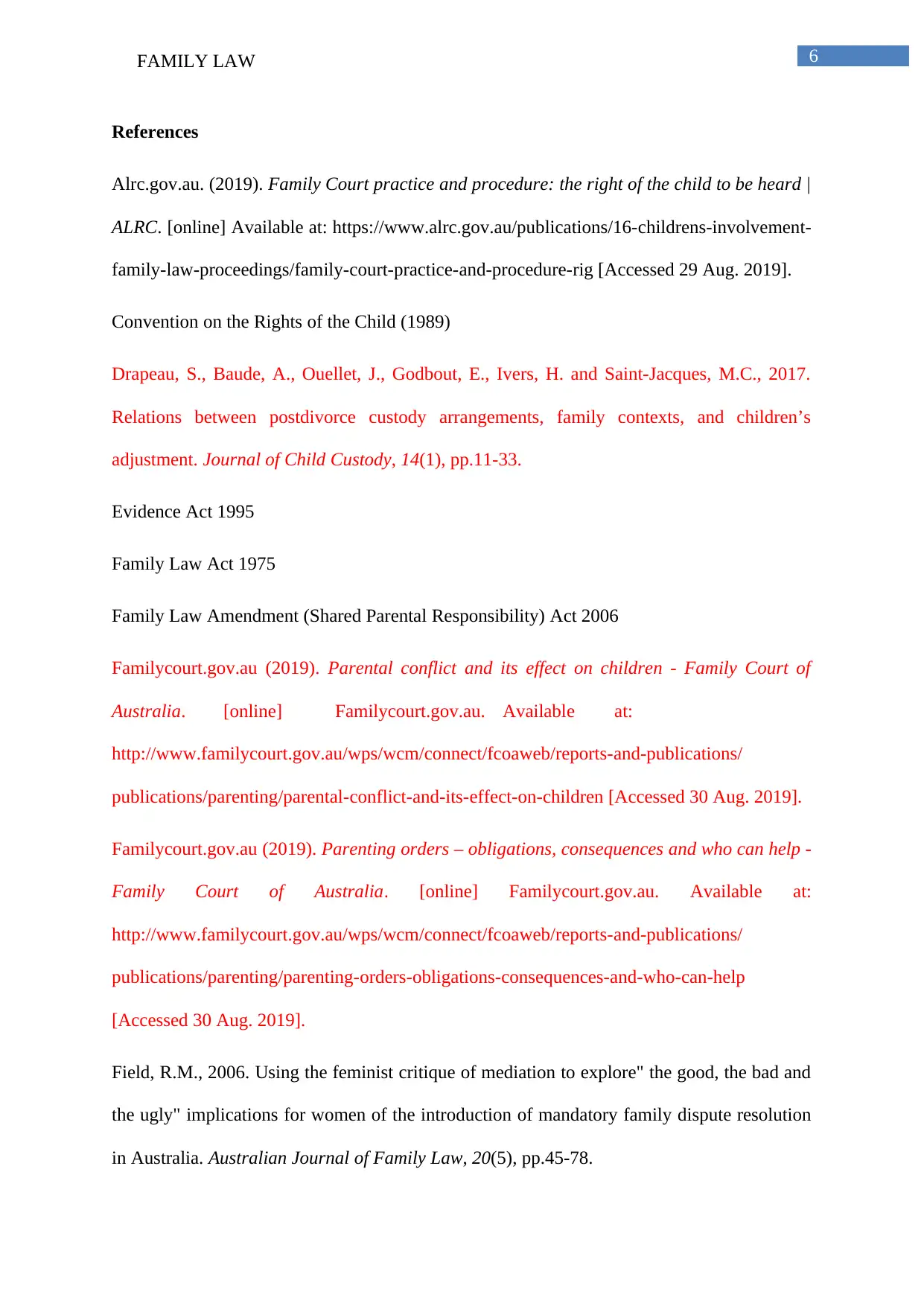
6FAMILY LAW
References
Alrc.gov.au. (2019). Family Court practice and procedure: the right of the child to be heard |
ALRC. [online] Available at: https://www.alrc.gov.au/publications/16-childrens-involvement-
family-law-proceedings/family-court-practice-and-procedure-rig [Accessed 29 Aug. 2019].
Convention on the Rights of the Child (1989)
Drapeau, S., Baude, A., Ouellet, J., Godbout, E., Ivers, H. and Saint-Jacques, M.C., 2017.
Relations between postdivorce custody arrangements, family contexts, and children’s
adjustment. Journal of Child Custody, 14(1), pp.11-33.
Evidence Act 1995
Family Law Act 1975
Family Law Amendment (Shared Parental Responsibility) Act 2006
Familycourt.gov.au (2019). Parental conflict and its effect on children - Family Court of
Australia. [online] Familycourt.gov.au. Available at:
http://www.familycourt.gov.au/wps/wcm/connect/fcoaweb/reports-and-publications/
publications/parenting/parental-conflict-and-its-effect-on-children [Accessed 30 Aug. 2019].
Familycourt.gov.au (2019). Parenting orders – obligations, consequences and who can help -
Family Court of Australia. [online] Familycourt.gov.au. Available at:
http://www.familycourt.gov.au/wps/wcm/connect/fcoaweb/reports-and-publications/
publications/parenting/parenting-orders-obligations-consequences-and-who-can-help
[Accessed 30 Aug. 2019].
Field, R.M., 2006. Using the feminist critique of mediation to explore" the good, the bad and
the ugly" implications for women of the introduction of mandatory family dispute resolution
in Australia. Australian Journal of Family Law, 20(5), pp.45-78.
References
Alrc.gov.au. (2019). Family Court practice and procedure: the right of the child to be heard |
ALRC. [online] Available at: https://www.alrc.gov.au/publications/16-childrens-involvement-
family-law-proceedings/family-court-practice-and-procedure-rig [Accessed 29 Aug. 2019].
Convention on the Rights of the Child (1989)
Drapeau, S., Baude, A., Ouellet, J., Godbout, E., Ivers, H. and Saint-Jacques, M.C., 2017.
Relations between postdivorce custody arrangements, family contexts, and children’s
adjustment. Journal of Child Custody, 14(1), pp.11-33.
Evidence Act 1995
Family Law Act 1975
Family Law Amendment (Shared Parental Responsibility) Act 2006
Familycourt.gov.au (2019). Parental conflict and its effect on children - Family Court of
Australia. [online] Familycourt.gov.au. Available at:
http://www.familycourt.gov.au/wps/wcm/connect/fcoaweb/reports-and-publications/
publications/parenting/parental-conflict-and-its-effect-on-children [Accessed 30 Aug. 2019].
Familycourt.gov.au (2019). Parenting orders – obligations, consequences and who can help -
Family Court of Australia. [online] Familycourt.gov.au. Available at:
http://www.familycourt.gov.au/wps/wcm/connect/fcoaweb/reports-and-publications/
publications/parenting/parenting-orders-obligations-consequences-and-who-can-help
[Accessed 30 Aug. 2019].
Field, R.M., 2006. Using the feminist critique of mediation to explore" the good, the bad and
the ugly" implications for women of the introduction of mandatory family dispute resolution
in Australia. Australian Journal of Family Law, 20(5), pp.45-78.
Paraphrase This Document
Need a fresh take? Get an instant paraphrase of this document with our AI Paraphraser

7FAMILY LAW
Hutchings v Clarke (1993) 16 Fam 452
McIntosh, J., Symth, B. and Kelaher, M., 2011. P1-237 Post-separation parenting
arrangements: patterns and developmental outcomes. Journal of Epidemiology & Community
Health, 65(Suppl 1), pp.A132-A132.
Hutchings v Clarke (1993) 16 Fam 452
McIntosh, J., Symth, B. and Kelaher, M., 2011. P1-237 Post-separation parenting
arrangements: patterns and developmental outcomes. Journal of Epidemiology & Community
Health, 65(Suppl 1), pp.A132-A132.
1 out of 8
Your All-in-One AI-Powered Toolkit for Academic Success.
+13062052269
info@desklib.com
Available 24*7 on WhatsApp / Email
![[object Object]](/_next/static/media/star-bottom.7253800d.svg)
Unlock your academic potential
Copyright © 2020–2025 A2Z Services. All Rights Reserved. Developed and managed by ZUCOL.